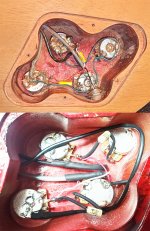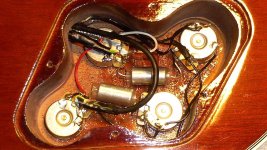Upgrading the harness will do certain things depending on the parts used. You can get pots with different tapers, which means that how quickly or smoothly the sound changes will be different with a 15% audio taper vs a 30% taper or a linear taper. What these numbers mean is that for a 500K pot, a 15% will measure 75K ohms when turned 50%. A 30% taper will measure 150K ohms at the mid point. Linear taper means it will be 250K when turned half way. Since volume is a logarithmic function (because we hear that way), the use of a log measurement is supposed to make it more like what you hear. Turn it up from 50% to 100% and it sounds twice as loud.
The capacitor value will make a huge difference in the brightness. In the typical humbucker setup, a .022uF cap is used. The higher the value, the darker the sound as you roll off the control. You might even want to have different values, like .015 for a neck pickup vs .022 for the bridge. I really don't hear a difference between the Vishay metal film caps that Heritage uses and an oil filled cap. The Vishay caps are good units.
If you can solder, then it's not hard to make up a harness. I made a template out of a piece of cardboard, and soldered everything except the pickup and switch on the cardboard. Then I mounted the pots, connected the caps and ground wire and installed it. This is the result.
View attachment 31849
Finally there's vintage wiring scheme vs modern wiring scheme. You can read how these differ lots of places. Seymour Duncan has wiring diagrams for each type.
https://www.seymourduncan.com/resources/pickup/wiring-diagrams
For Heritage guitars, you want short shafted pots.
That's all for now. It's a fairly easy job assuming you can solder.



